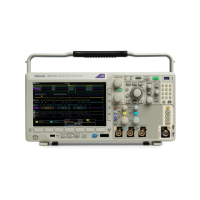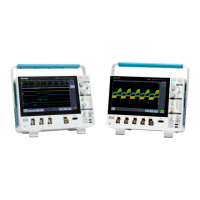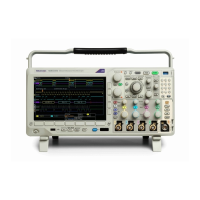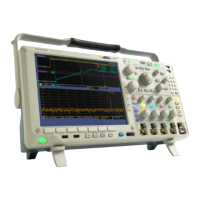
Do you have a question about the Tektronix MDO3014 and is the answer not in the manual?
| Bandwidth | 100 MHz |
|---|---|
| Vertical Resolution | 8 bits |
| Form Factor | Benchtop |
| Vertical Sensitivity | 1 mV/div to 10 V/div |
| Power Analysis | Optional |
| Operating Temperature | 0 °C to +50 °C |
| Channels | 4 |
| Record Length | 10 Mpoints |
| Display | 800 x 480 |
| Input Impedance | 1 MΩ ± 1% in parallel with 13 pF ± 2 pF |
| Connectivity | USB, LAN |
| Trigger Types | Edge, Pulse, Runt |
| Built-in Spectrum Analyzer | Yes (up to 3 GHz) |
| Protocol Analysis | I²C, SPI, CAN, LIN, RS-232/422/485/UART, USB |
| Dimensions | 425 mm × 222 mm × 145 mm (16.7 in × 8.7 in × 5.7 in) |
Provides essential safety precautions for product operation and damage prevention, urging users to read all instructions.
Details additional information required for safe service procedures, emphasizing that only qualified personnel should perform service.
Highlights the main capabilities and integrated functionalities of the MDO3000 Mixed Domain Oscilloscopes.
Provides key operating specifications for the MDO3000 Series Oscilloscopes, including power, weight, and environmental limits.
Details the procedure for safely powering on the oscilloscope, including proper grounding connections.
Provides a quick functional check to verify the oscilloscope is operating correctly after initial setup.
Guides users on the automatic probe compensation procedure for specific Tektronix passive probes.
Describes the process of Signal Path Compensation to correct DC inaccuracies and ensure warranted performance.
Provides instructions for downloading and installing the latest firmware for improved oscilloscope functionality.
Explains methods for connecting the oscilloscope to a computer for data analysis and control.
Guides users on setting up analog channels for signal acquisition using front panel controls and knobs.
Details how to use the Autoset function to automatically configure optimal oscilloscope settings.
Explains the FastAcq feature for high-speed waveform capture, useful for transient signal anomalies.
Guides users on setting up serial and parallel bus triggering for decoding and analysis.
Guides users on selecting and setting up different trigger types available on the oscilloscope.
Details how to set up bus triggers, enabling analysis of multiple data buses with appropriate application modules.
Instructions for taking automatic measurements like frequency, period, and pulse width.
Guides automatic measurements in the frequency domain, such as channel power.
Details measuring potential differences using the digital voltmeter.
Explains using on-screen cursors for manual waveform measurements.
Details using the FFT function for frequency domain analysis.
Explains using Wave Inspector controls for efficient navigation of long record length waveforms.
Details monitoring signals against masks and performing pass/fail tests.
Explains analyzing power signals with the Power Analysis Module.
Guides saving and recalling waveform/trace data.
Explains security features like TekSecure for memory erasure and password protection.
Introduces optional application modules that extend oscilloscope capabilities and describes their functionalities.











